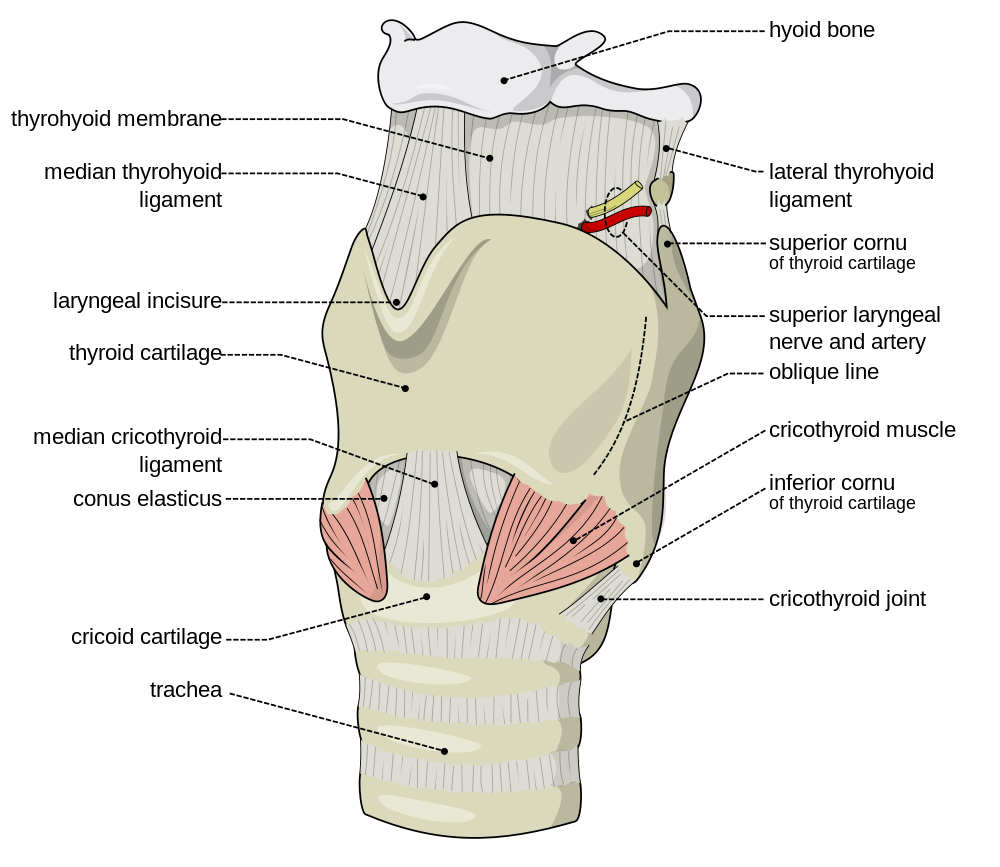 The larynx, commonly referred to as the ‘voice box’, is an organ in the neck between the tongue and trachea. It is involved in breathing, sound production, and protecting the trachea against food aspiration. The structure itself houses the vocal folds and laryngeal musculature essential to speaking and singing.
The larynx, commonly referred to as the ‘voice box’, is an organ in the neck between the tongue and trachea. It is involved in breathing, sound production, and protecting the trachea against food aspiration. The structure itself houses the vocal folds and laryngeal musculature essential to speaking and singing.
You should be able to locate your larynx fairly easily by placing your thumb and index finger on either side of your upper neck. Now, swallow and feel for a ‘bump’ that moves up and down in your throat. That is your larynx. In order to create different vowel and consonant combinations during phonation, the larynx MUST be able to move and function freely. An easy way to test this is by speaking the word ‘all’ while pretending to yawn. You should feel the larynx descend to a low, comfortable position. Now, spread your lips and speak the word ‘cat’ in a bright, child-like voice. Do you feel your larynx ascend somewhat to produce that word? Continue to experiment with different laryngeal positions by speaking and singing various words and feeling for movement.
There are entire voice training methods dedicated to achieving and maintaining a low, stable laryngeal position at all times during singing. As noted above, the problem with this approach is that the larynx NEEDS to be free to move in order to create specific vowel sounds at specific pitch and dynamic levels while singing. How can it do this if it is constantly being manipulated into the same low position at all times? This goes against basic, cause-and-effect anatomy and physiology. Simply put, if the voice is functioning freely, then the larynx is already where it needs to be in a performer’s throat. There is no reason to fuss over its position.
 Now, some will say, “But what if the larynx is out of wack!”. This can and does happen. However, that, too, can often be fixed without trying to directly manipulate laryngeal positioning. We accomplish this via changes in vowel/vocal tract shaping. While that may sound simple, there are actually many factors involved in optimal vowel shaping, including: stylistic parameters, pitch requirements, registration, tongue position, mouth position, jaw position, soft palate position, breath pressure, and more. If any of these factors are out of wack, laryngeal positioning issues can occur. This is why it is important to work with a voice teacher who knows how to help students produce healthy sounds for various music styles. Different styles require different vowel and technical adjustments (and, as a byproduct only, different laryngeal positions).
Now, some will say, “But what if the larynx is out of wack!”. This can and does happen. However, that, too, can often be fixed without trying to directly manipulate laryngeal positioning. We accomplish this via changes in vowel/vocal tract shaping. While that may sound simple, there are actually many factors involved in optimal vowel shaping, including: stylistic parameters, pitch requirements, registration, tongue position, mouth position, jaw position, soft palate position, breath pressure, and more. If any of these factors are out of wack, laryngeal positioning issues can occur. This is why it is important to work with a voice teacher who knows how to help students produce healthy sounds for various music styles. Different styles require different vowel and technical adjustments (and, as a byproduct only, different laryngeal positions).
The main takeaway from all this: It’s OK to be aware of what the larynx is doing in your throat, but it’s often counter-intuitive to stress over and try to manipulate it directly. Undesirable laryngeal positioning is rarely the main underlying cause of vocal issues (though it can be in specific cases). Truthfully, we don’t have a lot of direct control over laryngeal height during vocalization anyway. Instead, poor laryngeal positioning is most often a symptom of other issues (i.e. bad vowel shaping). While there are individuals trained and certified to perform laryngeal massages and make direct adjustments, do NOT attempt to do these things if you are not one of those people. We’re talking about the most important structure for singing in our bodies. Be smart.
P.S. Need help finding musical theatre repertoire to sing? Check out my professional repertoire guides here.
You really make it seem really easy together with your presentation however I to find this matter to be really one thing that I feel I would by no means understand. It kind of feels too complex and very large for me. I’m looking ahead in your subsequent submit, I’ll try to get the hold of it!
Thanks a bunch for sharing this with all folks you actually understand what you are speaking about! Bookmarked. Kindly additionally consult with my website =). We can have a hyperlink alternate contract between us!
hello!,I like your writing very a lot! percentage we keep in touch extra about your article on AOL? I need a specialist in this area to unravel my problem. Maybe that’s you! Looking forward to see you.